This page is an automated translation of /nl/santoantao.html and is awaiting a manual review.
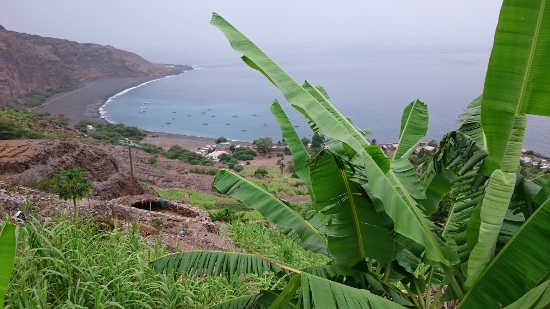
In a previous episode we wrote about a Dutch couple that we had met at El Hierro. In Mindelo we met them again: they want to stay on the Cape Verde to build a new life there. It clicks and we like that they are there. Carolien has now been to Santo Antao and discovered the town of Tarrafal de Monte Trigo there. She thinks it is an ideal anchorage. Tarrafal is an authentic Cape Verdean fishing village that can only be reached by sea or by 4x4 trip on unpaved paths for a few hours. It all sounds ideal and so we decide to take a look there. Mark and Carolien will follow a few days later when they have settled some cases in Mindelo.
After a short sailing trip of four hours we arrive at Tarrafal. Our pilot (handbook) is not enthusiastic about Tarrafal and therefore few sailors come here. After we have successfully completed the anchor procedure we swim to the huge black beach at dusk. We don't know where to go, but three guys come to us. They turn out to be locals and they ask if we prefer to return by boat instead of swimming. We still have to think about that, but it is handy that they are there because they can immediately show us the way to a nice place to eat something. They bring us to Mar Tranquilidade, a beautifully set up location, founded by a German/American couple who arrived here with a sailing boat about 15 years ago. The first guests were backpackers who slept on the beach, today's guests travel in the back of a pickup truck and take large suitcases.
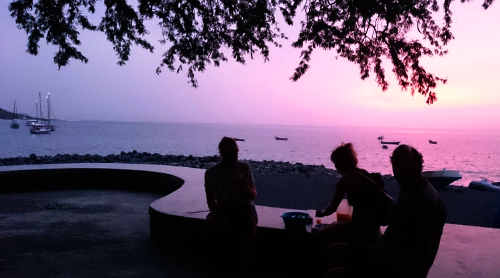
We are just in time for the "sundowner", a daily gathering on the beach where while enjoying a drink (there is a large jar with a fruit/alcohol brew that you can tap as needed) the setting sun is watched and given also immediately put a glass in their hands. The owner strongly advises us to take a boat back, he himself would not go swimming in the dark, even though he says he is not exactly scared. He sets the price for us because people here sometimes have the tendency to ask unrealistically high amounts. Not because they are bad people, but because the tourists taught them that. The buffet is great and we are very excited about the nice place. When we go back, one of the boys comes to us and he says that the agreed price is not right, it must be more. Yeah bye. So not he! That was not agreed and we say that we actually thought the amount was a bit high (it was 10 euros for 100 meters of rowing) but no problem, we do swim. Nice, that sounded cool, but now we really have to swim. Especially Ilona does not think this is such a great plan, but we also do not want to be put off and we think it is important that the boys learn that it is not smart not to keep your agreements. So we walk down the pitch-black beach. No moon, but clouds and we see very little. We have arrived at the place closest to the boat. We get dressed and go into the water, Frans takes the lead very bravely. Ilona hesitates. Brrr, that's really pitch dark and there might be sharks here? A feeling of unease emerges but come on, it's only 100 meters and there aren't many ... Ilona goes after Frans, face tight with tension but hey, what is this? The twinkles are back !! A big grin appears and it does not come off during the swim to the boat. Where you move with your arms in front of you, it glitters and twinkles so brightly that a disco ball falls into insignificance. How beautiful that is to swim through! And of course there are no sharks.
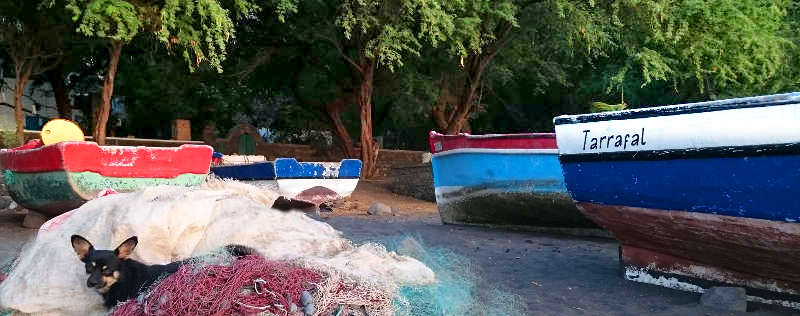
It's green here; there is rich vegetation and the village is hidden under a beautiful green blanket. We learn that nevertheless it hardly ever rains here: it is so green here because water vapor in the form of clouds/rain hits the mountain on the north side of the island and this runs via (underground) streams to this valley. What a luxury, no rain, but green!
Tarrafal
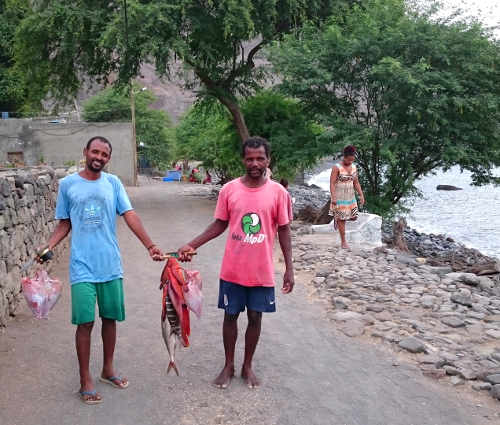
As a sailor, you have to deal with some formalities on arrival on every Cape Verde island. To our surprise we don't have to go to the police (because they don't seem to have them here) but to the local centipede "Simon" who handles all the formalities. He is a master at the school, arranges the formalities, runs the local tourist information office combined with a bar, plays in a music band, organizes events, and so on. And he also masters the French Language so that we can communicate with him. When we ask the villagers where Simon is, we are referred to the school.
On the way we have time to see the village that is built along a winding sandy path that first follows the sea and then meanders up the mountain. Chickens and dogs are everywhere, but the sandy path is remarkably clean. A little later we see why: the sandy path is regularly swept and is therefore spotless. There is a large football field, but the surface does not consist of grass but of the same hard black volcanic sand as the rest of the island. We find it hilarious that the villagers all walk on flip-flops or bare feet, but that football is taken so seriously that football boots and high socks are worn exclusively and especially for football. And of course football shirts. This is the outfit worn in more developed countries so that's how it should be. The football shirts are all different and seem to be giveaways from previous tourists; we even see shirts with Dutch advertising texts!
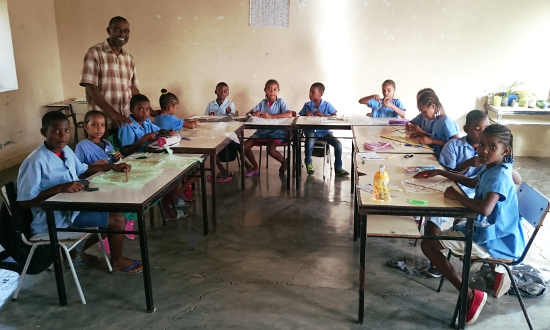
In the middle of the schoolyard is a large banana tree. Simon appears to be teaching but we are encouraged to walk in and Simon beckons us in enthusiastically as soon as he sees us. So a little later we are in the middle of an African classroom. Simon likes us to be there and explains that he teaches the children that tourists are good for the village. Oh yes, and while we're here, whether we might also want to buy tickets for the Christmas party. When our lottery tickets are drawn, we can determine where the proceeds from the whole lottery go to. Simon hopes that this will benefit the school: the children get food at school to relieve the parents and to ensure that the children get at least a good meal per day, but this project costs the school a lot of money. Of course we buy some lottery tickets and because we cannot attend the drawing we write our wish in a notebook. We also brought some sets of colored pencils from the Netherlands to hand out, but who better to determine who needs it than Simon? And of course Simon is very happy with that. Simon also organizes other events: soon they will have a clean-up day where all pieces of plastic from nature are collected. Because, as on any island, plastic is a major problem: plastic ends up in the sea all over the world and washes up everywhere on islands. Simon tries to arrange for the Cape Verde Islands to become "plastic-free". We think this is a commendable endeavor. And unbelievable how much energy this man has for all his tasks and ambitions!
Waterfall

The village lies on a valley that contains fresh running water and thus forms the lifeline of the village. The water is of vital importance to the people here as drinking water and as water to irrigate the crops. High in the valley there is even a real waterfall, and a French speaking boy, Ravy, invited us to go to the waterfall with him. Mark and Carolien have now also arrived and the five of us are on the road. It would only be about a two-hour walk, but Ravy advises us to wear walking shoes. We think it's crazy, especially when Ravy shows up at the appointment in slippers. Phew, does he really think that Europeans cannot walk for two hours without walking shoes?
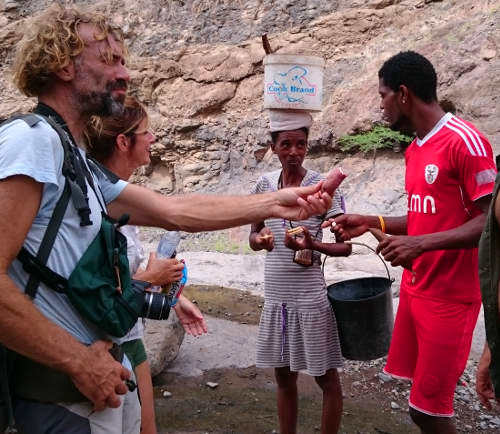
What we see when we walk into the valley exceeds our wildest expectations! There is a wealth of banana trees, sugar cane, papaya trees, breadfruit and everything else that we don't recognize. The people here want to make the best possible use of the water and have built a whole system of channels, terraces, hoses and pipes to guide the water past all the plants. It's Sunday but people are working everywhere. All people who greet us with kindness and wait patiently when Ravy explains to us. From the mountain comes a woman with a bucket on her head containing some fruit, apparently just picked or dug up for lunch. There are some kind of tubers/roots, but we really do not understand what these products are. Ravy takes one from the bucket and gives us all a piece to taste. It is indeed unknown to us, but it tastes quite good. The female wants to give us the rest because of that success, but we can't eat her family's lunch, can we? The people here have little, but are generous despite that. We give the woman some cookies back in exchange and a little later we meet a woman who carries a gas bottle on her head. We also offer her a biscuit, the gas bottle is released to be able to accept the biscuit and to our surprise, the heavy round gas bottle neatly balances on her head while munching. Ravy explains that the men do the heavy lifting here, but that the women take care of the transport. A lot of cement is needed for all water channels and it is the women who transport the 25 kg bags on their heads through the mountains.

We get higher and higher in the valley, it is more and more climbing and scrambling. We have a hard time with it but our guide looks like a mountain goat in slippers! We are happy to have walking shoes on and Ravy has to help us through difficult parts regularly. We sweat and drink gallons of water. Ravy stays completely dry and hardly eats and drinks. He regularly encourages us with "we are almost there". When we finally arrive at the waterfall I am so overheated that I stand under the waterfall with clothes and all. I stay under it for 15 minutes and enjoy the refreshing water, which according to all insiders is also excellent drinking water. Ravy thinks it's crazy that I let my clothes get wet. I think that's crazy, because at least that way I stay cool longer and by the time we are down it is all dry again for a long time. Ravy only goes under the waterfall for a very short time and after he has his shirt still dry, he is shivering and chattering his teeth. Hence! He shouldn't think about having to put on wet clothes too!
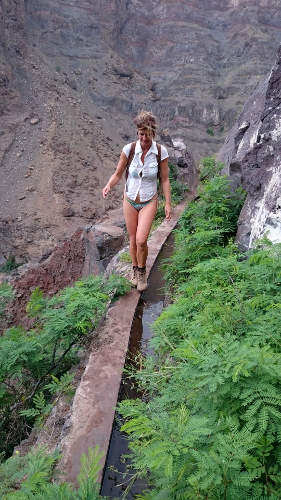
For the way back, Ravy suggests following a constructed canal to a mountain village and from there descend again to Tarrafal. The "channel" is about 15 centimeters wide, with a 20 centimeter wide masonry edge on both sides. The canal is a few kilometers long and meanders through the mountains to the water-needy village. We walk over the 20 centimeter wide edge, but the abyss keeps getting deeper. The entire "channel" is in some places only 35 centimeters wide and is stuck to the rock wall with a steep precipice of a hundred meters or more. One small mistake and you're done. It makes me very anxious and the rest of the company seems to find it very exciting. I have to make an effort not to panic. Ravy thinks it's crazy and hops over the narrow edge in his flip-flops and keeps insisting that we're almost there and that we just shouldn't look down. We were able to walk just fine on that 20 centimeter wide edge, right?
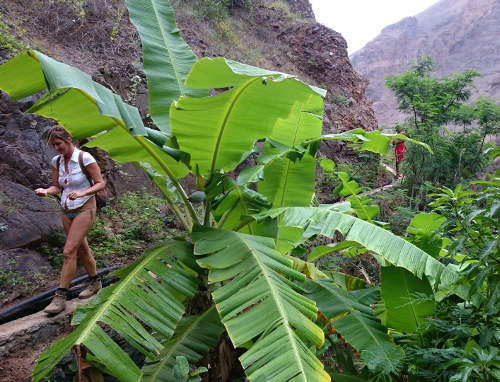
We are relieved when we finally arrive in the village. Ravy introduces us to two women and tells us that these two women travel the same route every day with a bag of cement on their heads! The canal must be maintained and here and there it is expanded. We ask if she is the mother of the girl standing next to her but she turns out to be the grandmother! Go on, grandma with a 25 kg bag of cement on her head balancing over a 20 centimeter wide ledge crossing the abyss? We are getting more and more respect for these people!
Progress
The valley and the sea gave the people here everything they needed. Unfortunately not anymore. Electricity has come into the village, and with it television. And through television, people see the apparent luxuries and opulence that people have in other parts of the world, and the advertising makes people believe that they need all those products to be happy.
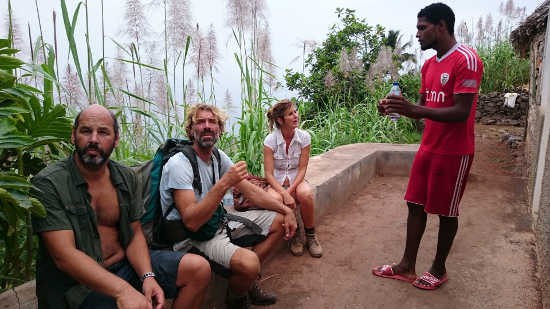
The sea here is still full of fish and the valley is still green, but the valley does not grow smartphones, fabric softeners, and other important happiness-enhancing products. We think that people here do not realize how happy they can be with a climate that offers a pleasant temperature for them in both summer and winter, where it hardly ever rains, but they nevertheless live in a green landscape, with all year round a wealth of tropical fruits and a varied fish offer for food, not being plagued by bureaucratic silliness, and so on. How can we tell them that as tourists while we walk around here with smartphones, cameras, sunglasses, walking shoes, etc.? We think the houses in which the people live are cute, the lack of windows makes perfect sense, but people are now ashamed of their "poverty" and would rather not let us take pictures. The people all look healthy. Here and there a tooth is missing, but no one is too fat or too thin, no one is crooked, and the people here work in the valley or in fishing until old age.
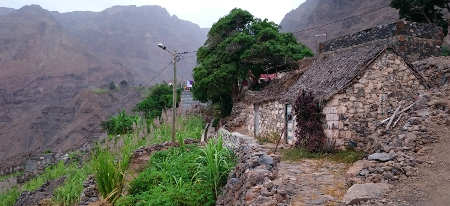
A few European has discovered this paradise and moved to live there. The owners of Mar Tranquilade, of course, but also a Swiss who has built a house against the mountain. Mark and Carolien meet him and they are immediately invited for lunch, which includes a large sea bream in the oven. However, that fish is a bit too big, so we are also invited to come and help with food. A little later, for example, we sit down for a very extensive lunch with someone we don't know at all. Where we look out over the bay including the two Dutch sailing yachts that moor there. The view is never boring: Bernhard says that he finds it very entertaining to see another sailor trying to get ashore with an inflatable boat. The sea is very powerful here and an inflatable boat goes upside down with some regularity. Finally, Bernhard shows us his washing machine, because it is the only and first washing machine in this village, and villagers regularly come to see this miracle of technology ...
Nocturnal restlessness
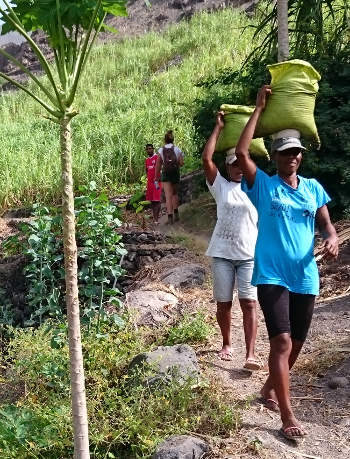
The previously very calm sea is becoming increasingly restless. We use our inflatable boats to get to land, but it is getting more and more difficult to get to land or to re-enter the water. The fishermen here do all this very routinely and know exactly which wave to wait for and how fast to row. We are less adept at this and sometimes things almost go wrong. When we want to go back to our boat from the land, there are a few girls right next to our inflatable boat who show no interest in us. Until the moment when our timing at the launch is not completely clear and a breaking wave comes rolling in while we are just about to row away. Suddenly, Ilona is no longer in a boat but in a bathtub and we try to save the situation by just rowing away as if it were the most natural thing in the world, but the girls have seen the fiasco and laugh at us unabashedly. They roar with laughter and are jumping and dancing on the beach. Well, we white people can have a lot of stuff, but we are super clumsy: we cannot properly enter and exit the water with our boats, we are afraid of falling into the abyss, we cannot dance well, we get despite our walking shoes pain in our feet when we have to walk a bit, we can't stand the sun, and so on. In their eyes we are probably some kind of clowns from another world.
The next day the sea is even more turbulent. None of that was predicted. Our sailing boats go up and down violently and just behind us the waves splash on the beach. We hear the big stones rolling on the beach. Around noon, Ilona and Carolien are looking for the internet, Mark is drawing at the bar of the holiday resort, and I am the only one on board because I still had a job to do there. When I look up I suddenly see Mark and Carolien's boat right next to our boat, and that was not the case before. So at least one of the boats is walking and I realize my options are limited on my own. Luckily Mark has seen it from the bar too so he improves the record running, going into the water and rowing, and a little later we analyze the situation. Fortunately, no boat got loose, but it seems that at least one of the two has shifted the anchor over the ground. We look at things for a while and call the ladies that they should come back because the sea is getting so violent that it may not work later.

The four of us are on board Mark and Carolien's boat a little later. The situation is now stable, but it seems sensible to start running that night. One person can easily keep an eye on two boats so if each of us sacrifices 2 hours then we will probably get through the night safely. But both boats are on a 50 meter chain and if a little later "Bloem" floats to the other side of "Omweg" this means that the anchor chains will cross each other. And that is not good. Meanwhile, everything indicates that it is not our boat that has changed position, so Mark and Carolien have to anchor again. Just before dark it is ready and they are again at a safe distance from us. But the sea is getting very rough now. Directly behind our boat, the waves break and explode with enormous noise on the stone-strewn beach. Ever larger stones are thrown onto the beach. Then suddenly it starts to blow. Not just a little, but with huge gusts of more than 30 knots. And always from a different direction. This was not predicted either. But if our anchor now loosens we will be in the surf within a few seconds and then on the rocks. We turn in all directions, sometimes at a depth of 10 meters, but sometimes only 5 meters. We start the engine to be able to sail away immediately if necessary. The sun is down, there is no moon, and it is getting so dark here that we can no longer see the ominous scene but of course still hear and feel it. Moments later Mark calls us on the VHF to tell us that they do not trust it and are going out to sea. We also decide to go, prepare the boat in record time and a few minutes later both boats sail into the darkness.
The sea is calmer just outside the bay. There is also no more strong wind. So it was either a temporary phenomenon or a strange local effect that disturbs the bay. Returning in the night is absolutely not an option so we have to spend the night at sea. Normally not a problem, but we were now a bit unprepared for the sea. Not an easy meal for the taking, not sufficiently rested, the inflatable boat still dragging behind us, the solar panels still extended, and so on. We motor a few miles out to sea and turn the motor off, because we don't want to go anywhere. The only thing we see at some distance is the light in the top of Bloem's mast. Fortunately, we also have radar because we don't want to float against an unlit object. Without motor and sails we float around and we see that there is a current from half a knot to the north. For the time being there is nothing in the way so we will leave it that way. It is annoying that without motor or sail we no longer have any significant steering and the boat will lie transversely to the waves. We roll back and forth furiously and sleep very little. When the sun rises again, the sea is calm, but once back in the bay, there is still a considerable swell. We anchor again and see that the coastline has changed significantly. The stone-free area where the fishermen launched their boats is now completely covered with stones. So it has done a lot of damage here and we are glad that we had a disrupted night, but the boat and we are still intact. We do decide, however, that we will no longer do things here where we have to leave the boat alone for a long time.
Activities
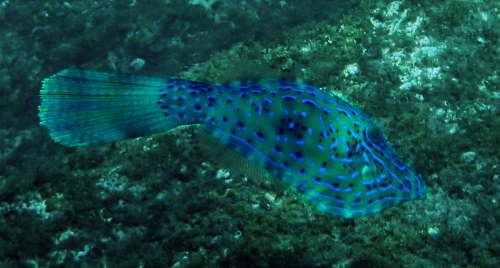
We don't do very much, but we enjoy ourselves very well here: it is nice with the people who are here and the weather is super nice: 35 degrees, plenty of sun and no wind because in this bay it hardly ever blows. We dance on a fun evening with real Cape Verdean live music that does not require a plug/amplifier, but which still sounds very good and nice and rhythmic. Ilona is asked to dance by several Cape Verdean boys and with good leaders it seems as if she is not dancing Cape Verdean dance for the first time when they swing across the dance floor. Incidentally, the dance facility consists of a concrete gray block with two cold white lights as the only decoration; there is no money here but the fun is no less. We practice landing our dinghy on the beach, sometimes it goes well but often we get soaked but who would mind when it is 35 degrees? We chat with the local people and enjoy the tranquility and observe the different culture. We go on a snorkeling adventure with the dinghy; we sail down the coastline, drop the dinghy anchor at beautiful places and explore the underwater world. Wonderful, here are completely different and even more beautiful fish than on the Canary Islands!
Time to go

It is time to move on and as we have stayed here much longer than planned and we have to take into account the rest of the schedule, we decide not to visit the other Cape Verde islands. We would have liked very much to visit Brava, but unfortunately the time is not unlimited and we make the choice not to visit here again.
In Tarrafal de Monte Trigo there is not much fruit and vegetables for sale, so we go to Porto Novo for that. That means that we get into the dinghy at a quarter to five in the morning and have to land on the beach in pitch dark (unfortunately the moon is already below). It is going surprisingly well. At five o'clock Aluguers drive from Tarrafal to Porto Novo. Aluguers here are 4x4 cars, usually pick-up trucks, with a few seats inside and a few outside in the back. The cars are full and we have to sit in the back of the back. Nice you would say, but we have been warned by everyone that it is very dusty and angry and that you better sit inside. This turns out to be true, especially during the first hour it is difficult to stay seated as we go on the unpaved stony paths through the mountains. Of course, they don't know seat belts here either. The surface is so rough that a solid all-terrain tire just punctures. Apparently this happens more often because the driver is extremely skillful in changing the wheel. However, the ride is very special and we are happy that we experienced this and when we return we have enough fruit and vegetables for the coming weeks on the ocean because we are almost leaving for Suriname!